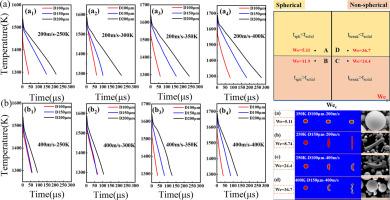Insight into the influence of melt superheat on flow field dynamics and particle morphology in gas-atomized Fe-based amorphous alloys: Simulation and experimental
IF 14.3
1区 材料科学
Q1 MATERIALS SCIENCE, MULTIDISCIPLINARY
引用次数: 0
Abstract
Powder morphology exerts a profound influence on the forming quality of additive-manufactured components, which is vastly dependent upon the control of the gas atomization process. This work systematically investigates the impact of melt superheat upon atomization flow field dynamics and particle morphology for Fe-based amorphous alloys across a superheat temperature range of 250–400 K in terms of combined numerical simulations and experiments. A multistage numerical model incorporating secondary breakup and solidification deformation was developed using the realizable k-ε turbulence model, discrete phase model, and volume of fluid method. Results reveal that there is a slight influence on the flow field at lower superheats (250–350 K). Yet, at a superheat up to 400 K, the recirculation zone elongates and the secondary acceleration zone disappears, which leads to an increment in the proportion of fine droplets and a transition in the droplet size distribution from normal to monotonically declining tendency. In the droplet solidification deformation stage, a higher superheat or larger initial droplet diameter appears to enhance the solidification time, beneficial to yield spherical powder. Further, a novel criterion for spherical powder formation was established in relation to the Weber number (We). The experimental data depict that the proportion of spherical powder improves substantially, from 23% to 74%, as superheat rises from 250 to 400 K, closely matching theoretical predictions. This in-depth understanding of powder formation mechanisms in gas atomization provides valuable guidance for optimizing spherical powder yield.

熔体过热对气雾化铁基非晶合金流场动力学和颗粒形貌影响的研究:模拟与实验
粉末形貌对增材制造零件的成形质量有着深远的影响,而成形质量的好坏很大程度上取决于气体雾化过程的控制。本文采用数值模拟和实验相结合的方法,系统地研究了熔体过热对铁基非晶态合金在250 ~ 400 K过热温度范围内雾化流场动力学和颗粒形貌的影响。采用可实现的k-ε湍流模型、离散相模型和流体体积法建立了包含二次破碎和凝固变形的多级数值模型。结果表明,在较低过热度(250 ~ 350 K)时,对流场的影响较小。而在400k过热时,再循环区延长,二次加速区消失,导致细液滴比例增加,液滴尺寸分布由正态向单调下降转变。在液滴凝固变形阶段,较高的过热度或较大的初始液滴直径会延长凝固时间,有利于形成球形粉末。此外,建立了与韦伯数(We)有关的球形粉末形成的新准则。实验数据表明,当过热度从250 K上升到400 K时,球形粉末的比例从23%大幅提高到74%,与理论预测非常吻合。这种对气体雾化中粉末形成机制的深入理解为优化球形粉末产量提供了有价值的指导。
本文章由计算机程序翻译,如有差异,请以英文原文为准。
求助全文
约1分钟内获得全文
求助全文
来源期刊

Journal of Materials Science & Technology
工程技术-材料科学:综合
CiteScore
20.00
自引率
11.00%
发文量
995
审稿时长
13 days
期刊介绍:
Journal of Materials Science & Technology strives to promote global collaboration in the field of materials science and technology. It primarily publishes original research papers, invited review articles, letters, research notes, and summaries of scientific achievements. The journal covers a wide range of materials science and technology topics, including metallic materials, inorganic nonmetallic materials, and composite materials.
 求助内容:
求助内容: 应助结果提醒方式:
应助结果提醒方式:


